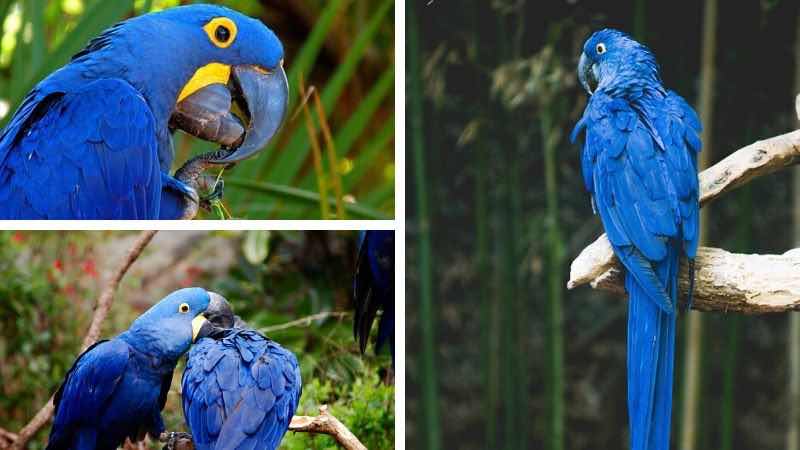
Taxonomy, habitat, feeding, reproduction, behavior
The Hyacinth Macaw (Anodorhychus hyacinthinus), or blue macaw, as it is called in Brazil is a bird belonging to the family of macaws and parrots (Psittaciforme). It is said to be the largest parrot in the world.
Its average size ranges from 70 to 105 cm long, and it weighs 1.5 to 1.7 kg, and of great beauty, with its blue feathers, contrasted with the black under-feathers, its curved and pointed black beak, with a yellow stripe at the junction of the beak and the head and around the eyes.
When it opens its mouth, the yellow part moves, making a fold like an accordion. Its beak is very strong, capable of breaking hard seeds.
Where does the Blue Macaw live?
It mainly inhabits the jungles of Brazil, Bolivia and northern Paraguay, preferring lowlands and humid formations. It feeds on fruits, nuts, and drupes of palm trees (acuri, bocaiúva).
It utilizes clay, rich in mineral salts, which it collects in some saline areas, to neutralize toxins ingested in unripe fruits.
It nests in the hollows of trees, where the female lays two eggs, of which usually only one survives — the first to hatch and the focus of the mother’s attention during the first three months.
It reaches sexual maturity at seven or eight years of age.
Anodorhychus hyacinthinus endangered…
Overexploited for the beauty of its feathers, and threatened by the illegal pet trade, deforestation and forest fires, it had been considered extinct, but reappeared in the jungles of southern Brazil, specifically in the state of Piauí.
It can now be observed in the north and south of the Pantanal, which is located in the states of Mato Grosso and Mato Grosso do Sul.
It is said that this bird is used in some drug traffickers’ shelters to warn of the proximity of the police, as they shout the words: “The police are coming”.
Behavior of the Hyacinth Macaw
They travel in pairs or in small flocks of up to ten birds. They are monogamous birds.
They nest in trunk cavities, usually of the manduvi tree. The female lays eggs every two years.
It is a bird of exceptional beauty, highly sought after as a pet. Rick Jordan, author of a guide to parrots (2009), says that the blue parrot is a sweet, intelligent pet that adapts quickly to people.
It has the disadvantage of adopting a person as a partner in the house, preventing others from approaching it.

Dr. Rafael Cartay is a Venezuelan economist, historian, and writer best known for his extensive work in gastronomy, and has received the National Nutrition Award, Gourmand World Cookbook Award, Best Kitchen Dictionary, and The Great Gold Fork. He began his research on the Amazon in 2014 and lived in Iquitos during 2015, where he wrote The Peruvian Amazon Table (2016), the Dictionary of Food and Cuisine of the Amazon Basin (2020), and the online portal delAmazonas.com, of which he is co-founder and main writer. Books by Rafael Cartay can be found on Amazon.com
This post is also available in:
![]() Español (Spanish)
Español (Spanish)
